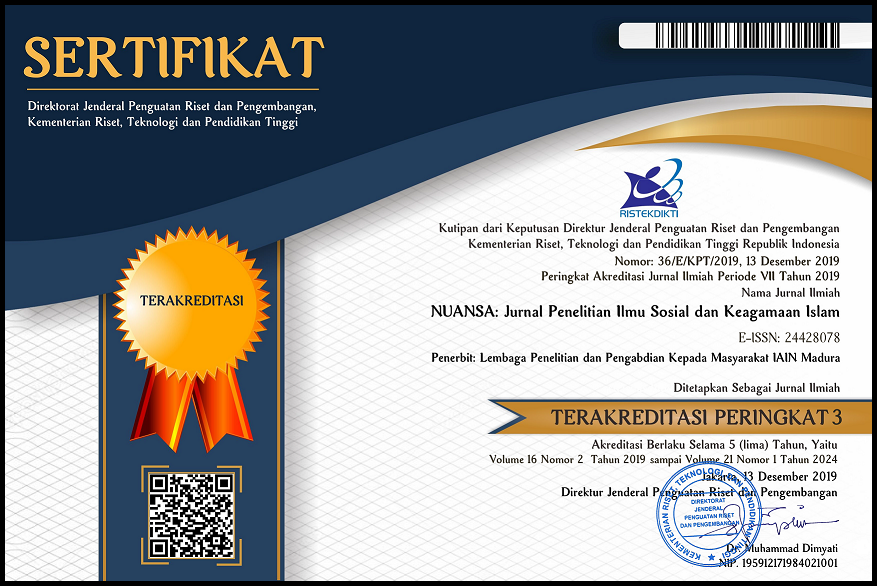Love for All Hatred for None: Ajaran Teologis dan Respon Ahmadi terhadap Perusakan Masjid Miftahul Huda di Media Sosial
 Abstract views: 612
,
Abstract views: 612
,
 pdf downloads: 298
pdf downloads: 298
Abstract
As a result of their religious understanding that is considered different by the dominant group (mainstream), Ahmadiyah - especially those of the Qadian faith - are often the object of persecution in Indonesia with hatecrime nuances. Persecution involves collaboration between community organizations as civil society and the state, forming the phenomenon of godless nationalism. One form of persecution became the public spotlight due to the destruction of the Miftahul Huda mosque in Sintang Regency, West Kalimantan. Although the mosque attack ended on September 3, 2021, in fact, violence against the Indonesian Ahmadiyah Congregation (JAI) continued to occur afterwards. JAI was attacked through social media. This research method is qualitative with a virtual ethnography approach, which is further analyzed using social construction of technology (SCOT). This research tries to see how Ahmadiyah's religious doctrine responds to the violence they experience. And to what extent the teachings of Ahmadiyya's love of peace are realized in Ahmadi when responding to attacks after the destruction of the Miftahul Huda mosque, especially attacks that target JAI's official Instagram account, @ahmadiyah.id. The findings in this article show that the Ahmadiyya teachings have experienced persecution since their birth in India, and throughout the world. Facing this, Ahmadiyya responded with a religious doctrine of love and peace represented by the phrase love for all, hatred for none which is a form of interpretative flexibility in the review of social construction of technology. The response given by the Ahmadis looks passive and tends to be defensive, it is in accordance with their religious doctrine not to reply to anyone who hurts them.
(Akibat pemahaman keagamaannya yang dianggap berbeda oleh kelompok dominan (mainstream), Ahmadiyah – khususnya yang beraliran Qadian – sering menjadi objek persekusi di Indonesia yang bernuansa kebencian (hatecrime). Persekusi melibatkan kolaborasi antara organisasi masyarakat sebagai civil society dengan negara membentuk fenomena nasionalisme bertuhan. Salah satu bentuk persekusi menjadi sorotan publik akibat peristiwa perusakan masjid Miftahul Huda di Kabupaten Sintang, Kalimantan Barat. Meski penyerangan masjid telah usai pada 3 September 2021, nyatanya kekerasan terhadap Jemaat Ahmadiyah Indonesia (JAI) terus terjadi setelahnya. JAI mendapat serangan lewat media sosial. Metode penelitian ini adalah kualitatif dengan pendekatan etnografi virtual, yang lebih lanjut dianalisis menggunakan social construction of technology (SCOT). Penelitian ini mencoba untuk melihat bagaimana doktrin keagamaan Ahmadiyah merespon kekerasan yang mereka alami. Dan sejauh apa ajaran cinta damai Ahmadiyah terealisasi dalam diri Ahmadi ketika merespon serangan pasca perusakan masjid Miftahul Huda khususnya serangan yang menyasar akun instagram resmi JAI yakni @ahmadiyah.id. Temuan dalam artikel ini memperlihatkan ajaran Ahmadiyah yang telah mengalami persekusi sejak awal kelahirannya di India, dan seluruh dunia. Menghadapi itu, Ahmadiyah membalasnya dengan doktrin keagamaan cinta damai yang diwakili dengan kalimat love for all, hatred for none yang merupakan bentuk dari interpretative flexibility dalam tinjauan social construction of technology. Respon yang diberikan oleh para Ahmadi terlihat pasif dan cenderung defensif, hal itu sesuai dengan doktrin keagamaan mereka untuk tidak membalas siapa saja yang menyakiti mereka.)
Downloads
References
Ahmad, Mirza Masroor. Dan Jalan Menuju Perdamaian. Bandung: Neratja Press, 2014.
———. World Crisis and Pathway to Peace. Juli 2017. Tilford-Surrey: Islam International Publications Ltd, 2013.
Anderson, Benedict R. O’G. Imagined communities: reflections on the origin and spread of nationalism. Rev. ed. London ; New York: Verso, 2006.
Azra, Azyumardi. “Indonesia Islam, Mainstream Muslims and Politics.” Dalam Taiwanese and Indonesia Islamic Leaders Exchance Project. Taipei: The Asia Foundation in Taiwan, 2006.
Budiana, Yendra. “Siaran Pers: Fakta Lengkap Kronolgoi Perusakan Masjid Miftahul Huda di Desa Balai Harapan, Kecamatan Tempunak, Kabupaten Sintang, Provinsi Kalimantan Barat.” Sekretaris Pers & Juru Bicara Jemaat Ahmadiyah Indonesia, 9 Maret 2021.
Burhani, Ahmad Najib. “‘It’s a Jihad’: Justifying Violence towards the Ahmadiyya in Indonesia.” TRaNS: Trans -Regional and -National Studies of Southeast Asia 9, no. 1 (Mei 2021): 99–112. https://doi.org/10.1017/trn.2020.8.
Fanani, Faizal. “Ribuan Muslim Ahmadiyah Jadi Relawan Siaga Donor Darah Nasional.” Liputan6.com. 3 Mei 2020. https://www.liputan6.com/regional/read/4243997/ribuan-muslim-ahmadiyah-menjadi-relawan-siaga-donor-darah-nasional.
Ferdiansyah, Rendi. “Anak-Anak Warga Ahmadiyah tidak Aman di Sekolah.” Media Indonesia, 2 Juli 2016. https://mediaindonesia.com/nusantara/27697/anak-anak-warga-ahmadiyah-tidak-aman-di-sekolah.html.
Hakim, Lukman Nul. “TINDAK KEKERASAN TERHADAP JAMAAH AHMADIYAH INDONESIA: SEBUAH KAJIAN PSIKOLOGI SOSIAL.” Aspirasi: Jurnal Masalah-masalah Sosial 2, no. 1 (30 Juni 2011): 17–30. https://doi.org/10.46807/aspirasi.v2i1.435.
Hine, C. Virtual Ethnography. Londok, UK: SAGE Publication, 2000.
Indriani, Eva. “Konstruksi Sosial Keberadaan Jemaat Ahmadiyah Di Kota Medan.” Islam & Contemporary Issues 2, no. 1 (22 Maret 2022): 1–8. https://doi.org/10.57251/ici.v2i1.238.
Khan, Abid. “Religious Fanatics Attack Ahmadis’ houses in Sharanpur, Uttar Pradesh, India; six persons injured.” International Press and Media Desk Ahmadiyya Muslim Community. 27 Agustus 2008. http://www.thepersecution.org/world/india/08/08/pr27.html.
Klein, Hans K., dan Daniel Lee Kleinman. “The Social Construction of Technology: Structural Considerations.” Science, Technology, & Human Values 27, no. 1 (Januari 2002): 28–52. https://doi.org/10.1177/016224390202700102.
Maharani, Tsarina. “Jemaah Ahmadiyah Lapor Kasus Intimidasi, Komnas HAM Negara Lemah Melindungi Hak Warga.” kompas.com, 3 Februari 2020. https://nasional.kompas.com/read/2020/03/02/17155651/jemaah-ahmadiyah-lapor-kasus-intimidasi-komnas-ham-negara-lemah-melindungi?page=all.
Makruf, Muhammad Gufron. “The Concept of Jihad in the Perspective of Jemaat Ahmadiyah Indonesia.” Millati Journal of Islamic Studies 6, no. 1 (2021).
Maliki, Dewi Nurrul. “Resistensi Kelompok Minortias Keagamaan Jemaat Ahmadiyah Indonesia.” Jurnal Ilmu Sosial dan Ilmu Politik 14, no. 1 (2010).
Mariani, Nina. “Ahmadiyah, conflicts, and violence in contemporary Indonesia.” Indonesian Journal of Islam and Muslim Societies 3, no. 1 (1 Juni 2013): 1. https://doi.org/10.18326/ijims.v3i1.1-30.
McLaughlin, Eugene, dan John Muncie, ed. The Sage dictionary of criminology. London Thousand Oaks, Calif: SAGE, 2001.
Mulyana Ade. “Fakta Lengkap Kronologi Perusakan Masjid Ahmadiyah Sintang.” Akurat.co. 9 Mei 2021. https://akurat.co/fakta-lengkap-kronologi-perusakan-masjid-ahmadiyah-sintang.
Office of International Religious Freedom. “INDONESIA 2020 INTERNATIONAL RELIGIOUS FREEDOM REPORT.” United States Departement of State, 2020.
———. “International Religious Freedom Report for 2019.” United States Departement of State, 2019.
Parwito. “Aksi Donor Kornea Mata 3 Ribu Jemaah Ahmadiyah Pecahkan Rekor.” Merdeka.com, 23 Juli 2017. https://www.merdeka.com/peristiwa/aksi-donor-kornea-mata-3-ribu-jemaah-ahmadiyah-pecahkan-rekor.html.
Simamora, Apriadi Richi, Abdul Hamid, dan M. Dian Hikmawan. “Diskriminasi Terhadap Kelompok Minoritas Jemaat Ahmadiyah Indonesia (JAI) Di Tangerang Selatan.” Ijd-Demos 1, no. 1 (2019). https://doi.org/10.37950/ijd.v1i1.4.
Siregar, Nadia Imanda. “PENEGAKAN HUKUM TERHADAP PENGRUSAKAN RUMAH IBADAH JEMAAH AHMADIYAH ( STUDI KASUS PENGRUSAKAN MASJID JEMAAH AHMADIYAH KALBAR ),” 2022. http://repository.umsu.ac.id/handle/123456789/18763.
Sulistyati, Mardian. “Love For All, Hatred For None: Narasi Kemanusiaan dan Primasi Perlawanan Stigma Jemaat Ahmadiyah Indonesia.” JURNAL INDO-ISLAMIKA 5, no. 1 (25 Februari 2020): 147–68. https://doi.org/10.15408/idi.v5i1.14790.
Tempo.co. “Enam Jamaah Ahmadiyah Tewas Diserang Warga Cikeusik,” 6 Februari 2011. https://nasional.tempo.co/read/311404/enam-jamaah-ahmadiyah-tewas-diserang-warga-cikeusik.
Tim CNN Indonesia. “Kronologi sebelum Perusakan Masjid Ahmadiyah di Sintang.” CNN Indonesia, 9 April 2021. https://www.cnnindonesia.com/nasional/20210904110136-20-689644/kronologi-sebelum-perusakan-masjid-ahmadiyah-di-sintang.
Wahyuni, Tri. “Perempuan Ahmadiyah Belum Bisa Hidup Layak.” CNN Indonesia, 12 Agustus 2014. https://www.cnnindonesia.com/nasional/20141208154024-20-16690/perempuan-ahmadiyah-belum-bisa-hidup-layak/.
Zulkarnain, Iskandar. Gerakan Ahmadiyah di Indonesia. Yogyakarta: LKis, 2005.
———. “Materi Pemikiran Kalam Ahmadiyah.” Dipresentasikan pada Mata Kuliah Kalam dan Modernitas, Yogyakarta, 8 Januari 2021.
———. “Membedah Teologi Ahmadiyah yang Digugat.” Ahmadiyah.org (blog), 15 Desember 2013. https://ahmadiyah.org/membedah-teologi-ahmadiyah-yang-digugat/.
The journal operates an Open Access policy under a Creative Commons Attribution-NonCommercial 4.0 International License (CC-BY-NC) 
Authors who publish with this journal agree to the following terms:
- Authors retain copyright and grant the journal right of first publication with the work simultaneously licensed under a Creative Commons Attribution License that allows others to share the work with an acknowledgement of the work's authorship and initial publication in this journal.
- Authors are able to enter into separate, additional contractual arrangements for the non-exclusive distribution of the journal's published version of the work (e.g., post it to an institutional repository or publish it in a book), with an acknowledgement of its initial publication in this journal.
- Authors are permitted and encouraged to post their work online (e.g., in institutional repositories or on their website) prior to and during the submission process, as it can lead to productive exchanges, as well as earlier and greater citation of published work.





















